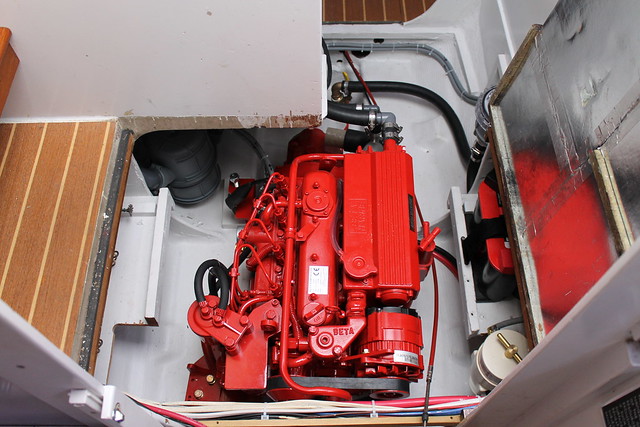We started hooking up the starboard engine today. Fuel filter and fuel lines are done. Raw water strainer is done. Still need to insert a vented loop between the heat exchanger and the exhaust elbow. Still need to install the battery, cables, and switch.
The port engine only needs a shaft, alignment, exhaust, and controls connected. Oh, and I almost forgot — a bilge pump. I'm not counting the secondary alternators as part of the engine installation. They need bigger cables run to the batteries and connection to the regulators. But you can see the space cut out for it in the image below.
The shafts should be ready in the morning. Hopefully we’ll have the shafts in, engines aligned and bolted down tomorrow. But there is a small additional complication. The shaft seals are sized for a 2” stern tube, but the stern tubes are more like 1.9”, probably something metric. On the port side they made a collar of some phenolic material to go over the stern tube and size it up to 2”. On the starboard side, there was a very thin piece of hose. That hose is not going to fly. Instead we’re going to take a piece of 2” OD fiberglass tube, mill it out to about 1.9”, and epoxy it onto the starboard stern tube. That has to be done before the starboard shaft can go in.
Another complication is that one of the bolts on the front right motor mount is completely obscured by the secondary alternator bracket. We should have drilled an access hole through the bracket before we put it on the engine. Actually, Beta should have done it before even sending it to me. This is definitely a double-jointed 8-year-old scenario. I’m not sure how were going to resolve it yet. Taking it off the engine and putting it in a drill press would be a delay at this point.
Fabrication of the exhaust surge chamber/gooseneck is ongoing. I think Ben is a welder trapped in a man’s body. Or something like that.
The highlight of my day was drilling a 1.125” hole through the bottom for the new generator thru-hull/seacock/strainer. The hull here at the leading edge of the keel is 7/8” thick. Our information about Take Two is that her hulls are made with strip planked red cedar, and the plug we drilled out smelled distinctly of cedar, which was cool.


